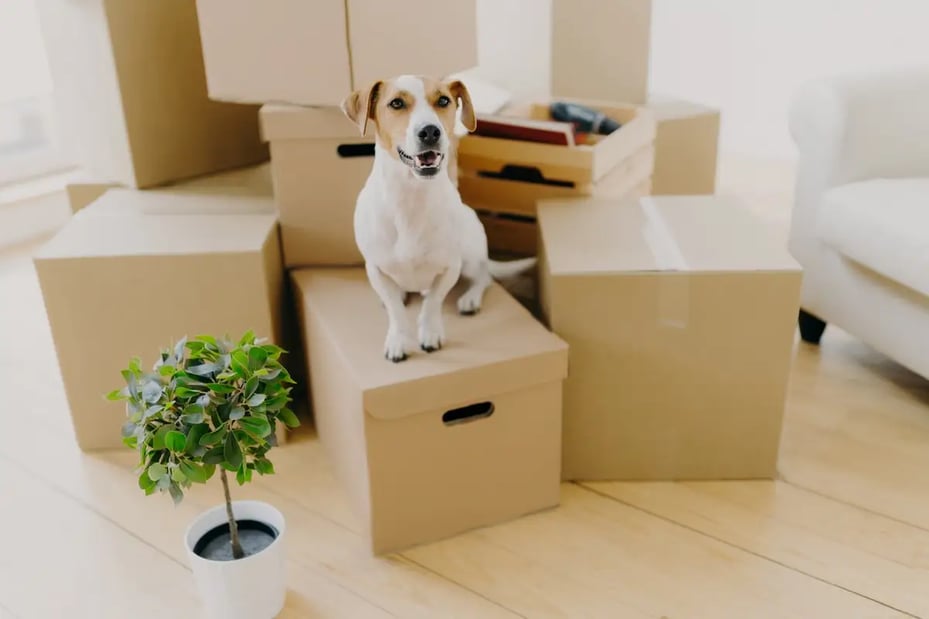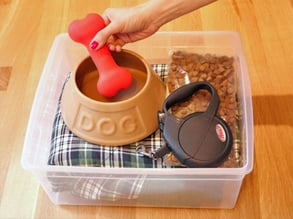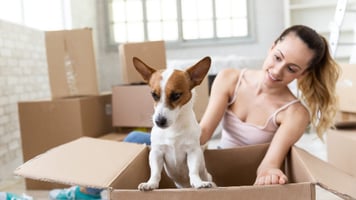12 Practical tips for a move with pets
When moving from home our pets can be as stressed as we are. Being a somewhat difficult process, they can feel restless as soon as they see you packing, and even when they arrive at the new home, it can be difficult to help them get used to and return to their usual routine. That is why, if you are thinking of moving, you should consider some important points to ease this transition.
Here are some practical tips to help your pet during the move and adapt to the new home.


Make sure to have your pet's collar updated before the move by putting the phone numbers and your new home address on his or her tags. This way if your pet gets lost during the move or in the new area, someone will be able to easily recognize who it belongs to and call you.
If possible, take your pets for walks in the area near your new home before you move. Its recommended that they get to know the new home beforehand, allowing them to explore and get to know the place. This will facilitate their adaptation.
3. Get to know the new area

If you can make these frequent visits, try to leave some of your pet's things progressively, that is to say, some toys and blankets, among other of your pets belongings. It is important not to move everything together to prevent the animal from feeling restless without their things in the old house.
Consider that their bed is an important object during the move. Since the new home is a different environment, the animal will need something to hold on to, which is usually where it sleeps. Make sure not to wash the bed for at least the first 2 weeks, this will depend on the pet's ability to adapt.
Place all their belongings in a single box and label it with your pet's name for easy identification. It is also important to keep this box close by and to have some useful things at hand, such as medicines, leashes, or grooming items.
Leave a separate water bowl and a food ration for the days before the move, as well as the essentials they might need (toys for a dog or cat litter).

This may only apply to cats or dogs of a small to medium size. During the journey you may need a carrier or transport crate, which can be a great tool or a problem if the pet has never been in such an enclosed space.
To help the animal get used to it, it is important to get the carrier ahead of time, placing some of its toys or blankets inside to teach them to feel safe. Also, make sure that the carrier cage you will use is adequate, with enough space and ventilation.
At this point, you should take into account the distance to travel to get to your new home. If it is a long distance by road, you should consider the following:
-
-
- Pets can get dizzy so it's recommended not to feed them as much during the hours before the journey begins.
- Before traveling, ask your veterinarian if any motion sickness medication may be necessary.
- Plan necessary stops for you and your pet.
- Drive carefully without sudden movements.
-
Remember that some companies or services do not allow you to take your pet in the moving truck.

On the day of the move, your house will be full of boxes and strangers carrying your belongings back and forth. It may not be safe for your pet to run loose, so you might want to consider implementing some of the following options:
A. Put your pet in a quiet room where there is some furniture, a bed, toys, and food to entertain them, keeping them away from the stress that the move my cause. Do this before the move in the old house and while you are setting up everything in the new one.
-
- Be sure to tell the movers or those who are helping you that they should not open the door where your pet is so that he/she does not escape.
B. Ask a family member or someone you trust if they can take care of your pet for the day until all your belongings and boxes are in the new house. This way, you will be able to resolve the move with more peace of mind.
-
- This will depend on how far away your new home is.
C. If you have decided to hire a professional service that offers to take care of your pet, have all the required documents ready and ask how they will keep you informed along the way until their arrival.
-
-
- To learn how to select the right company and know what to expect from the moving service you hire, visit our articles.
-
10. Recognizing the new home
Once in the new home, let your pet out so they can start to recognize and smell the place, even in the spaces it won't be able to enter for whatever reason. By taking them around the house you will be able to delimit the places where your pet can be; however, you can take the opportunity to firmly teach them not to climb on the bed or a specific couch according to your preferences.

11. A space for your pet
It is important that after recognizing the house or apartment, your pet has some freedom to choose their corner, space, or room to place their bed and toys. This to the extent possible and the limits that you decide.
Remember that animals are guided by the smells of the place or air currents, and choosing a space where they feel safe will help them to adapt.
12. Stick to their routine
To help your pets adapt smoothly to this transition, always try to stick to their schedule and daily routine.
The first few days they will probably feel uncomfortable, so give them time without changing their habits. For example, for dogs, frequent walks can calm the stress that the move may have caused.

-1.jpg?width=443&name=unnamed%20(1)-1.jpg)
Take all these tips into account and remember not to worry too much; your pet will eventually adapt to the new home just like you.

